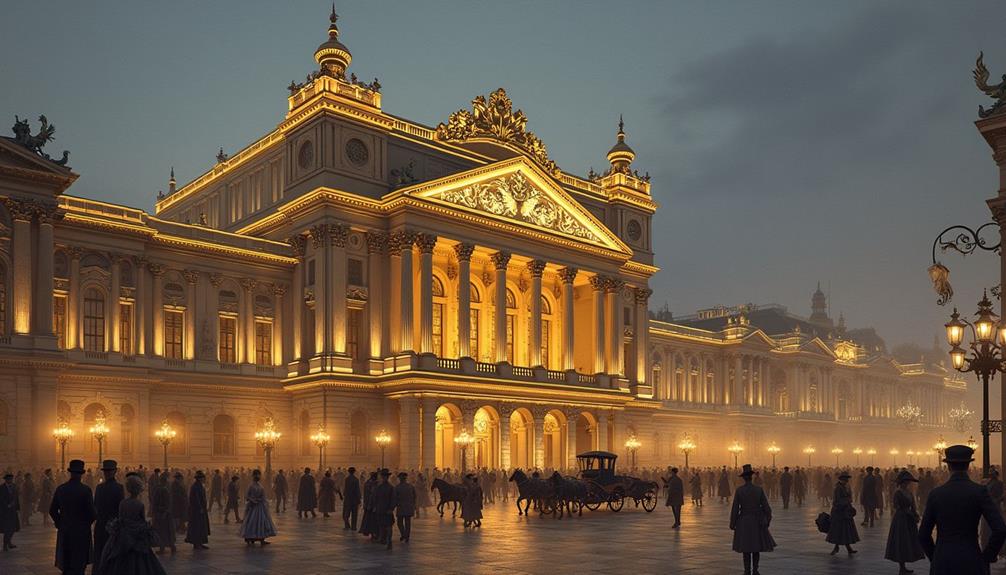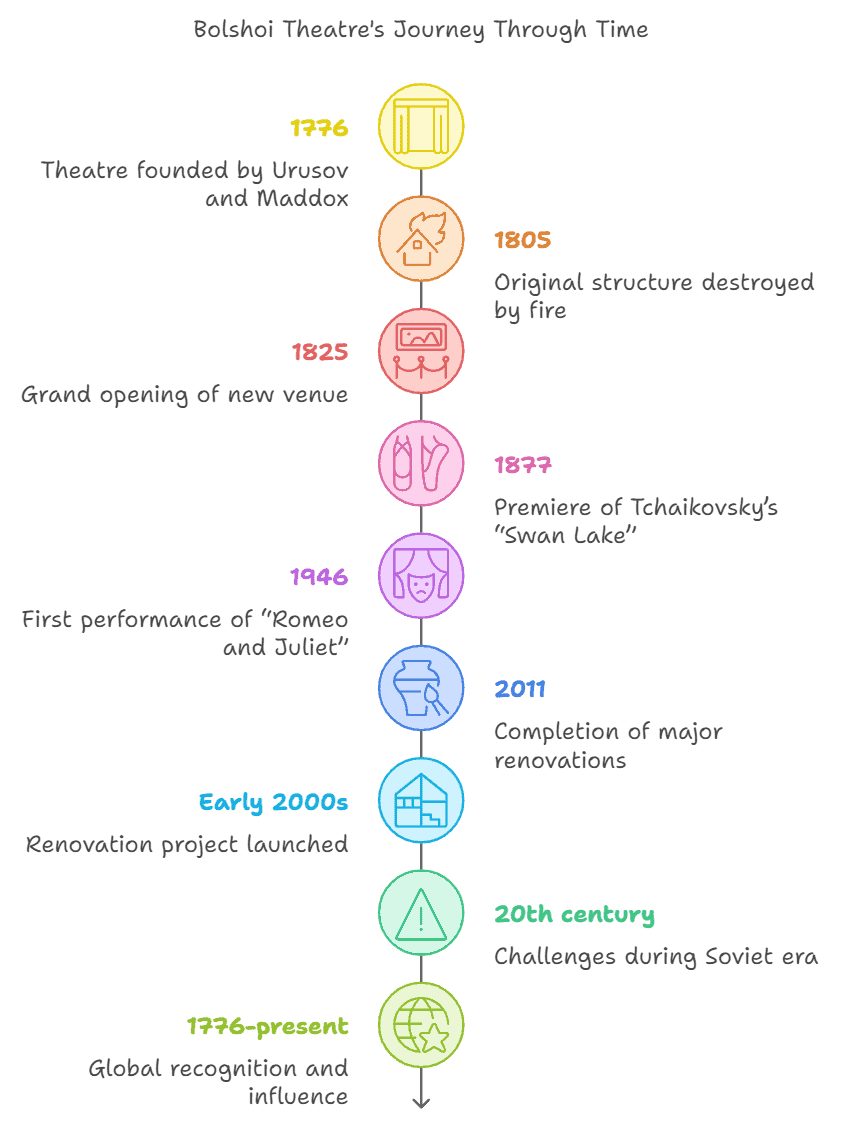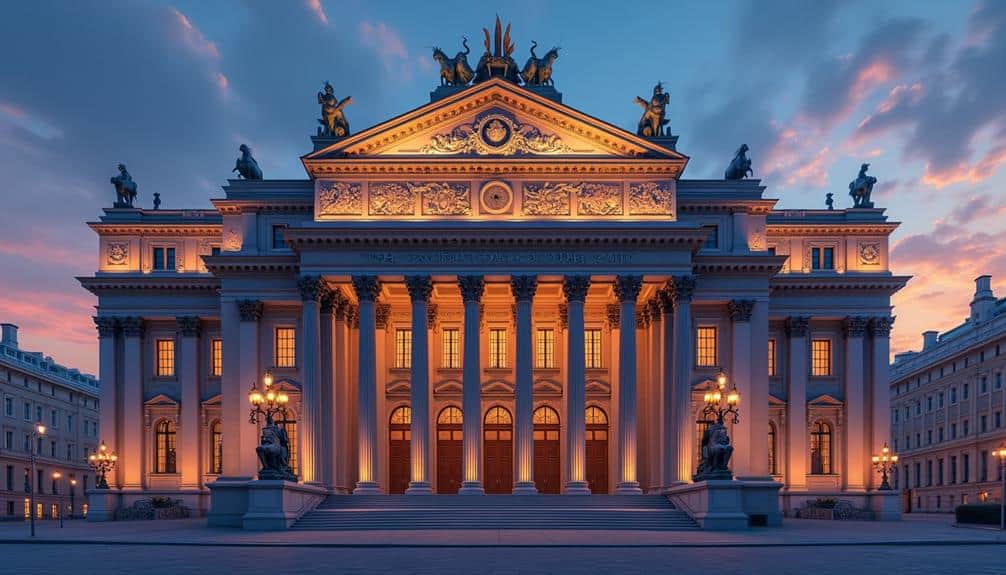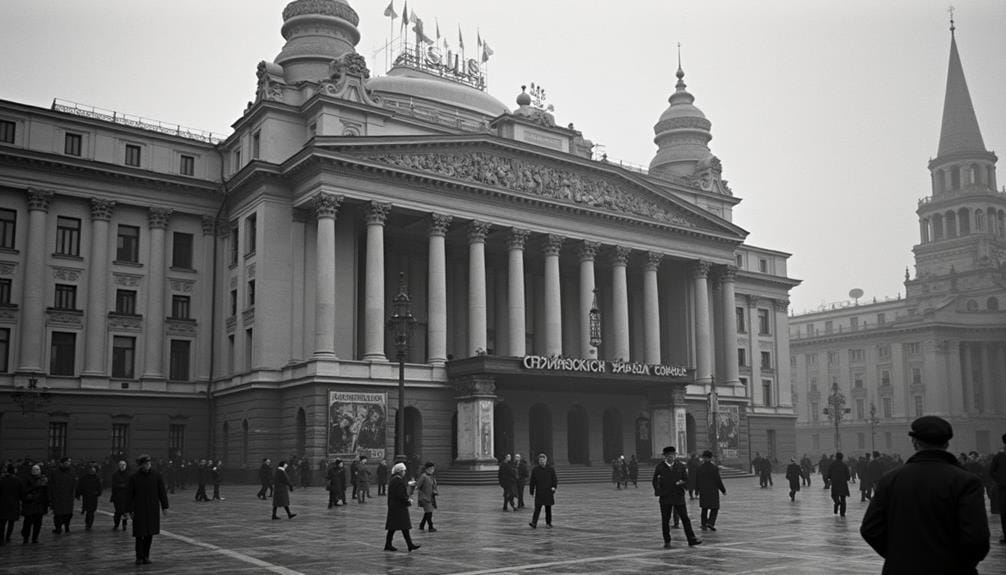The Bolshoi Theatre, with its illustrious origins dating back to 1776, has profoundly shaped Moscow’s cultural landscape. From its early days as a modest venue to becoming a global beacon of opera and ballet, the theatre’s journey is marked by architectural splendor and groundbreaking performances. Even in the face of Soviet-era adversities, it preserved its artistic integrity. Recent renovations have further enhanced its grandeur, blending tradition with modernity. What lies behind its enduring influence and the secrets of its celebrated legacy?
Watch our conversational video on the History of The Bolshoi Theater
Early Beginnings

Although the Bolshoi Theatre is now renowned as a symbol of Russian cultural heritage, its origins were modest. Founded in 1776 by Prince Pyotr Urusov and Michael Maddox, an English entrepreneur, the theatre initially served as a modest performance space in a private residence.
Despite its humble beginnings, the founders’ vision was grand: to create a thriving center for opera and ballet that would elevate Moscow’s cultural scene.
The theatre’s early years were marked by resilience and adaptability. Financial constraints and a devastating fire in 1805 that destroyed the original structure could have spelled the end for many ventures.
However, the determination to foster artistic freedom and cultural expression spurred its reconstruction. A temporary wooden theatre was erected, ensuring the continuity of performances and keeping the artistic spirit alive.

The Grand Opening
The resilience demonstrated in the early years set the stage for a pivotal moment in the Bolshoi Theatre’s history: the grand opening of its new, more permanent venue. On January 18, 1825, the Bolshoi Theatre revealed its grand edifice to an enthusiastic public, marking a significant chapter in Russian cultural history.
This event was more than just an introduction of a new building; it resonated with the aspirations of a nation yearning for artistic freedom and expression.
The inaugural performance featured “Fernando Cortez” by Gaspare Spontini, a choice that symbolized the theatre’s ambitions to blend international influences with Russian tradition. The opening night was attended by luminaries from diverse spheres of society, reflecting the theatre’s broad appeal and its role as a beacon of cultural enrichment.
The Bolshoi Theatre’s grand opening was not merely an architectural or artistic milestone; it was a manifestation of an unyielding spirit that had persevered through adversities.
It stood as a demonstration of the power of art in fostering a sense of collective identity and freedom. The theatre quickly became a central hub for the performing arts, setting a high standard for cultural institutions worldwide.
Architectural Marvel

From its inception, the Bolshoi Theatre has been celebrated not only for its performances but also for its architectural splendor. Designed by architect Joseph Bové, the grandeur of the Bolshoi Theatre is a reflection of neoclassical design, embodying elegance and artistic freedom. The exterior is dominated by a grand portico with eight Corinthian columns, culminating in a chariot of Apollo, the Greek god of arts, symbolizing the theatre’s dedication to the artistic muse.
Inside, the theatre’s opulence is immediately striking. The auditorium features six tiers of gilded balconies, each adorned with intricate stuccowork and plush red velvet seats that seem to invite patrons into a world of luxury and sophistication.
The crystal chandelier, weighing nearly three tons, hangs as a centerpiece, casting a warm, inviting glow over the audience.
The Bolshoi’s architectural majesty extends beyond mere aesthetics. The acoustics within the theatre are meticulously designed to enhance the auditory experience, ensuring every note reaches the audience with clarity.
This architectural ingenuity has cemented the Bolshoi Theatre as not just a venue for performances, but a landmark of cultural and historical significance, inspiring awe and admiration for generations.
Iconic Performances
Celebrated for its architectural magnificence, the Bolshoi Theatre has also hosted a plethora of iconic performances that have etched their mark on the global arts scene. Since its inauguration in 1825, the theatre has been a crucible for artistic innovation, presenting works that push the boundaries of classical ballet and opera. Among the most notable performances is the premiere of Tchaikovsky’s “Swan Lake” in 1877, a ballet that remains a cornerstone of the genre.
Moreover, the Bolshoi’s stage has been graced by luminaries such as Galina Ulanova and Maya Plisetskaya, whose interpretations have left indelible impressions on audiences worldwide. Sergei Prokofiev’s “Romeo and Juliet,” first performed here in 1946, further exemplifies the theatre’s role in fostering creative brilliance.
The Bolshoi has also been instrumental in introducing revolutionary productions like Dmitri Shostakovich’s opera “Lady Macbeth of Mtsensk,” which challenged conventional norms and expanded the artistic horizon.
The Bolshoi Theatre’s commitment to excellence continues to resonate today, as it hosts contemporary masterpieces while preserving the heritage of classical art forms. Its stage remains a beacon for artists and audiences who seek the liberating power of performance.
Soviet Era Challenges

Amid the shifting political landscape of the 20th century, the Bolshoi Theatre faced formidable challenges during the Soviet era. The imposition of strict ideological control and censorship by the Soviet regime profoundly impacted the artistic direction and repertoire of this historic institution.
Artistic freedom was severely curtailed as performances were required to align with state propaganda, glorifying communist ideals while eschewing any themes deemed counter-revolutionary or bourgeois.
Despite these constraints, the Bolshoi Theatre remained a beacon of artistic excellence. The theatre’s ability to adapt to the regime’s demands without compromising its high standards of performance is a reflection of the resilience and ingenuity of its artists.
Directors, choreographers, and performers had to navigate a labyrinth of political scrutiny while endeavoring to maintain the integrity of their craft. Significantly, the Bolshoi’s ballet and opera productions continued to garner international acclaim, even as they operated within the confines of Soviet orthodoxy.
Moreover, the Bolshoi served as a cultural ambassador during the Cold War, symbolizing Soviet cultural prowess on the global stage.
However, this period was fraught with tension, as artists walked the fine line between artistic expression and political compliance, yearning for creative freedoms that were often just out of reach.
Modern Renovations
The challenges of the Soviet era eventually gave way to a period of significant transformation for the Bolshoi Theatre. In the early 2000s, a thorough renovation project was launched to restore the grandeur of this iconic institution. The theatre had suffered from decades of neglect, and the ambitious plan aimed to rejuvenate its architectural splendor while incorporating modern technological advancements.
The restoration, completed in 2011, was an intricate blend of preservation and innovation. Skilled craftsmen meticulously restored the original 19th-century decor, ensuring historical accuracy.
Concurrently, state-of-the-art acoustic systems and stage technologies were integrated to meet contemporary performance standards. This included advanced lighting, audio, and stage mechanics, enabling the Bolshoi to host a wider array of productions with superior technical precision.
Particular attention was paid to enhancing audience comfort and accessibility. Seating was redesigned for improved sightlines, and modern amenities were added without compromising the theatre’s historical integrity.
The renovation also addressed structural issues, ensuring the building’s safety and longevity.
Today, the Bolshoi Theatre stands as a symbol of the harmonious fusion of heritage and innovation, offering audiences from around the world an unparalleled cultural experience.
Global Recognition
Gaining global recognition, the Bolshoi Theatre has long been heralded as one of the premier cultural institutions in the world. Its reputation for artistic excellence, particularly in ballet and opera, has made it synonymous with the pinnacle of performing arts. Founded in 1776, the Bolshoi has captivated international audiences with its grand productions and distinguished performers, solidifying its status on the global stage.
The theatre’s global acclaim is further emphasized by its extensive tours and collaborations with leading cultural organizations worldwide. Significantly, the Bolshoi Ballet has performed in prestigious venues from New York’s Lincoln Center to London’s Royal Opera House, enchanting audiences with its technical prowess and emotive storytelling.
These international engagements have not only extended the Bolshoi’s reach but also fostered cultural exchange, enriching the global arts landscape.
Moreover, the Bolshoi Theatre has embraced modern technology, streaming performances to audiences across the globe. This digital outreach guarantees that the Bolshoi’s artistic legacy is accessible to a wider audience, transcending geographical boundaries.
Legacy and Influence
Legacy and influence, two pillars of the Bolshoi Theatre’s enduring impact, underscore its unparalleled contribution to the world of performing arts. Established in 1776, the Bolshoi has not only shaped Russian cultural identity but has also set global standards in ballet and opera. Its productions, renowned for their artistic excellence, have influenced countless artists and institutions worldwide, fostering a spirit of innovation and excellence.
The Bolshoi’s commitment to nurturing talent through its prestigious ballet academy has produced a lineage of world-class performers. Legendary dancers like Galina Ulanova and Rudolf Nureyev have graced its stage, leaving an indelible mark on the art form. The theatre’s repertoire, rich with classical and contemporary works, continues to inspire choreographers and directors globally.
Moreover, the Bolshoi’s influence extends beyond the stage. Its architectural grandeur stands as a symbol of artistic freedom and cultural pride.
The institution’s resilience, having survived wars and political upheavals, embodies a spirit of perseverance that resonates with audiences seeking liberation through art.




